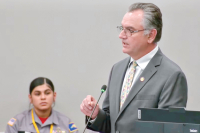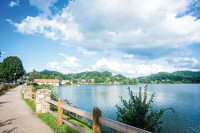A how-to crash course in smart growth
Ginny Faust, a professional planning consultant, posed a tough question to members of the Sylva Town Board and planning board last week.
Pick a building in Sylva that you’d proudly put on a postcard. With one caveat: it had to be built within the last 25 years. No one had a quick answer, which is just what Faust suspected.
“Today our buildings are built by national chains that want to be recognized wherever they are, so it creates the ‘Any Place’ phenomenon — no matter where you are everything looks the same,” Faust said.
It was one of several exercises during a planning workshop that prompted town leaders to think objectively about Sylva and whether its quaint character was holding up to the pressures of sprawl.
“What legacy do we want to leave our children? More places like this or this?” Faust asked, flashing a slide of Main Street followed by a picture of Wal-Mart’s parking lot. “Which place feels more welcoming to spend our time and money?”
Related Items
Everyone knows that Main Street simply feels nicer than the commercial sprawl on N.C. 107. After all, where do people send their out-of-town guests to kill time? But Faust wasn’t there simply to state the obvious. Her job was explaining tangible design features that can be replicated and applied by any new commercial development.
The “stark and barren” landscape that defines most commercial sprawl today is not something communities have to live with, Faust said. It’s simply knowing what kind of things to require in town codes to generate better development.
“We want to end up with better places where we want to spend time rather than get through them as quickly as possible,” Faust said.
Faust, who works for the state Division of Community Assistance in Asheville, gave the Sylva Town Board and planning board a crash course of the elements of smart growth, some of which could turn up in commercial design standards the town is embarking on. Here’s a few of them.
Parking lots
Sprawl — Buildings are plunked at the far end of parking lots with no street interaction, dwarfing the buildings and making a trip through town feel like a tour of parking lots. “Each building becomes an island pod of development floating in its own sea of asphalt parking so there is no relationship between the buildings and the street,” Foust said.
Solution — Pull buildings up to the street and place parking to the rear and side. Require uniform setbacks from the street so buildings create the feeling of a consistent street wall like you see in traditional downtown districts.
Building facades
Sprawl — Buildings with long, blank, blah walls. Appealing building design has been thrown out with the desire to build cheap buildings. “Buildings are built with cheap material and design and have a short life expectancy,” Faust said. Buildings like Wal-Mart don’t even have windows. “Windows and doors are inviting. When you don’t have them, it is seem very forbidding,” Faust said.
Solution — Require “articulation.” Articulation is anything that breaks up the monotony of long, blank walls. It can be any change in plane — like fake brick columns or recessed sections. Also, require windows.
Signage
Sprawl — Signs are big, tall and lit up like space ships to attract the attention of people zooming by in cars at 50 miles per hour. The looming beacons don’t feel friendly to people on the ground.
Solution — Require signs to be smaller and designed for the pedestrian, not high-speed viewing.
Foliage
Sprawl — There’s no trees in parking lots, along the front of the buildings or along streets. The lack of shade trees makes it hotter and feels less friendly.
Solution — Require trees in parking lots and along the street. Trees should be spaced the same distance apart and same distance back from the road to create the feeling of a pleasant tree-lined boulevard.
Walkability
Sprawl — Pedestrians have gone to the wayside. “Roads are noisy, hostile and dangerous unless you are in a car,” Faust said. Even parking lots are dangerous for pedestrians with no clear paths designated for people, who must scuttle out of the way of moving cars when navigating a parking lot.
Solution — Require sidewalks to be constructed in front of all new development. Require paths that lead from the sidewalk to the front door of the building, to visually connect the building to the rest of the community. Require pedestrian routes and raised, stamped crosswalks in parking lots.









